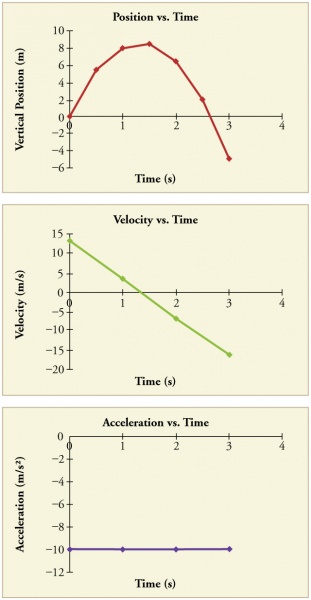A person standing on the edge of a high cliff throws a rock straight up with an initial velocity of 13.0 m/s. The rock misses the edge of the cliff as it falls back to Earth. Calculate the position and velocity of the rock 1.00 s, 2.00 s, and 3.00 s after it is thrown, neglecting the effects of air resistance.
Strategy
Draw a sketch.

Figure 1
We are asked to determine the position \(y\) at various times. It is reasonable to take the initial position \(y_0\) to be zero. This problem involves one-dimensional motion in the vertical direction. We use plus and minus signs to indicate direction, with up being positive and down negative. Since up is positive, and the rock is thrown upward, the initial velocity must be positive too. The acceleration due to gravity is downward, so \(a\) is negative. It is crucial that the initial velocity and the acceleration due to gravity have opposite signs. Opposite signs indicate that the acceleration due to gravity opposes the initial motion and will slow and eventually reverse it.
Since we are asked for values of position and velocity at three times, we will refer to these as \(y_1\) and \(v_1\); \(y_2\) and \(v_2\); and \(y_3\) and \(v_3\).
Solution for Position \(y_1\)
1. Identify the knowns. We know that \(y_0\ =\ 0 ;\ v_0\ =\ 13.0 \;m/s; \ a\ =\ −g=−9.80 \;m/s^2;\ and\ t=1.00 \;s\)
2. Identify the best equation to use. We will use \(y=y_0+v_0t+\frac{1}{2}at^2\) because it includes only one unknown, \(y\) (or \(y_1\)here), which is the value we want to find.
3. Plug in the known values and solve for \(y_1\).
| \(y_1=0+(13.0 \;m/s)(1.00\; s)+\frac{1}{2}(−9.80\;m/s^2)(1.00 \;s)^2=8.10\;m\) |
2.78 |
Discussion
The rock is 8.10 m above its starting point at \(t=1.00\;s\), since \(y_1>y_0\). It could be moving up or down; the only way to tell is to calculate \(v_1\) and find out if it is positive or negative.
Solution for Velocity \(v_1\)
1. Identify the knowns. We know that \(y0=0 ;\ v0=13.0\; m/s;\ a=−g=−9.80 \;m/s^2;\ and \ t=1.00 \;s.\) We also know from the solution above that \(y_1=8.10\;m\).
2. Identify the best equation to use. The most straightforward is \(v=v_0−gt\) (from \(v=v_0+at\), where \(a=gravitational\ acceleration=−g\)).
3. Plug in the knowns and solve.
| \(v_1=v_0−gt=13.0 \;m/s−(9.80 \;m/s^2)(1.00\; s)=3.20 \;m/s\) |
2.79 |
Discussion
The positive value for \(v_1\) means that the rock is still heading upward at \(t=1.00\;s\). However, it has slowed from its original 13.0 m/s, as expected.
Solution for Remaining Times
The procedures for calculating the position and velocity at \(t=2.00s\) and \(3.00\) are the same as those above. The results are summarized in Table 1 and illustrated in Figure 2.
| Time, t |
Position, y |
Velocity, v |
Acceleration, a |
| \(1.00 \;s\) |
\(8.10 \;m\) |
\(3.20 \;m/s\) |
\(−9.80\; m/s^2\) |
| \(2.00 \;s\) |
\(6.40 \;m\) |
\(−6.60\; m/s\) |
\(−9.80 \;m/s^2\) |
| \(3.00 \;s\) |
\(−5.10 \;m\) |
\(−16.4\; m/s\) |
\(−9.80 \;m/s^2\) |
| Table 1 Results |
Graphing the data helps us understand it more clearly.

Figure 2 Vertical position, vertical velocity, and vertical acceleration vs. time for a rock thrown vertically up at the edge of a cliff. Notice that velocity changes linearly with time and that acceleration is constant. Misconception Alert! Notice that the position vs. time graph shows vertical position only. It is easy to get the impression that the graph shows some horizontal motion—the shape of the graph looks like the path of a projectile. But this is not the case; the horizontal axis is time, not space. The actual path of the rock in space is straight up, and straight down.
Discussion
The interpretation of these results is important. At 1.00 s the rock is above its starting point and heading upward, since y1 and v1 are both positive. At 2.00 s, the rock is still above its starting point, but the negative velocity means it is moving downward. At 3.00 s, both \(y_3\) and \(v_3\) are negative, meaning the rock is below its starting point and continuing to move downward. Notice that when the rock is at its highest point (at 1.5 s), its velocity is zero, but its acceleration is still \(−9.80 \;m/s^2\). Its acceleration is \(−9.80\, m/s^2\) for the whole trip—while it is moving up and while it is moving down. Note that the values for \(y\) are the positions (or displacements) of the rock, not the total distances traveled. Finally, note that free-fall applies to upward motion as well as downward. Both have the same acceleration—the acceleration due to gravity, which remains constant the entire time. Astronauts training in the famous Vomit Comet, for example, experience free-fall while arcing up as well as down, as we will discuss in more detail later.